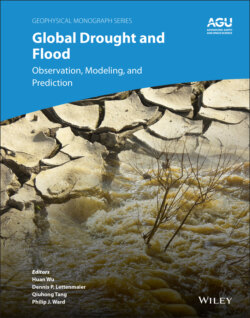Читать книгу Global Drought and Flood - Группа авторов - Страница 33
2.3.2. Extrapolation from Instantaneous to Hourly and Daily Fluxes
ОглавлениеA common technique for extrapolating instantaneous satellite‐based flux estimates to daily totals is to assume that the evaporative fraction (EF), given by the ratio of latent heat to the available energy, is constant during daylight hours for a given day (Gurney & Hsu, 1990; Shuttleworth et al., 1989; Sugita & Brutsaert, 1991). Given the value of EF determined at the ALEXI modeling time (t 2) along with hourly estimates of R n and G at times t i, which can be obtained from GOES, hourly values of system sensible and latent heating can be computed for days with clear mornings as (Anderson et al., 1997):
(2.7)
(2.8)
Previous studies have shown that daily total fluxes estimated using the EF measured at midday underestimate observed totals by 5–10% (Brutsaert & Sugita, 1992; Crago, 1996; Gurney & Hsu, 1990; Sugita & Brutsaert, 1991; Zhang & Lemeur, 1995), therefore EF is defined here as:
(2.9)
using flux components computed at modeling time t 2.
For clear pixels, hourly fluxes from the soil component of the two‐source system are obtained as:
(2.10)
(2.11)
(2.12)
while the canopy components are determined as residuals:
(2.13)
(2.14)
Hourly E Ci and E Si are integrated to provide the daily total water extractions 〈E C〉 and 〈E S〉 used to update the root zone and soil surface moisture pools.
For cloudy pixels, hourly values of latent heat flux are simply estimated from hourly potential evapotranspiration PET i and contemporaneous stress function values, while sensible heat is computed as a residual to the component energy budget:
(2.15)
(2.16)
(2.17)
(2.18)
